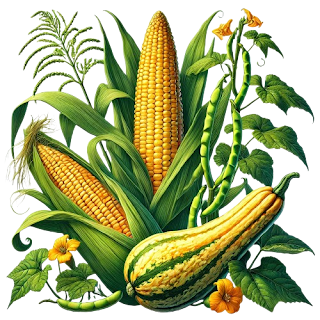Introduction
Three Sisters Gardening is more than just a planting technique—it’s an ancient agricultural practice rooted in the sustainable and symbiotic relationships of corn, beans, and squash. This method, perfected by Indigenous peoples of North America centuries ago, offers a blueprint for harmonious coexistence with nature. Today, the resurgence of interest in this age-old practice reveals its historical importance and its relevance to modern gardening. In this blog, we’ll explore the rich history of Three Sisters Gardening, its cultural significance, and the timeless lessons it provides for sustainable agriculture.
The Origins of Three Sisters Gardening
The story of Three Sisters Gardening dates back over 5,000 years to the agricultural practices of Indigenous tribes such as the Haudenosaunee (Iroquois), Hopi, and Cherokee. These communities revered corn, beans, and squash as sacred crops and referred to them as the "Three Sisters" because of their interdependent relationship, both in the garden and as a source of nourishment.
This planting method wasn’t accidental; it was rooted in a deep understanding of ecology. Corn served as a natural trellis for beans to climb, beans enriched the soil with nitrogen, and sprawling squash vines provided ground cover to suppress weeds and retain moisture. Together, these plants created a mini-ecosystem that thrived with minimal human intervention.
Cultural Significance of the Three Sisters
For Indigenous peoples, the Three Sisters were more than just crops—they symbolized sustenance, community, and balance. These crops were celebrated through ceremonies, stories, and seasonal festivals. For example, the Haudenosaunee cultivated the Three Sisters in mounds, which represented the cycle of life.
One of the most powerful tales is the Haudenosaunee legend, where the Three Sisters are depicted as three inseparable sisters who watch over and nurture the people. Corn provided structure, beans represented support, and squash symbolized protection. This mythology reinforced the deep connection between humans and nature and emphasized the need for cooperation and reciprocity.
Evolution of the Technique Over Centuries
Over time, the Three Sisters technique evolved as Indigenous communities refined their agricultural practices. Archaeological evidence shows that early farmers selected seeds from the healthiest plants, ensuring future crops were more resilient and productive.
European settlers in the 1600s learned about the technique from Indigenous peoples, helping them establish sustainable farms. However, the Industrial Revolution and the rise of monoculture farming overshadowed traditional methods like the Three Sisters. Despite this, the wisdom of this practice persisted in Indigenous communities and has seen a revival in modern gardening movements focused on sustainability and permaculture.
Why the Three Sisters Gardening Technique Matters Today
As global concerns about food security and environmental degradation grow, the Three Sisters Gardening technique offers a model for sustainable agriculture. Modern gardeners and farmers are embracing this method to reduce dependency on synthetic fertilizers, conserve water, and promote biodiversity.
The principles of the Three Sisters also resonate with today’s emphasis on eating local, organic produce. Corn provides essential carbohydrates, beans are rich in protein, and squash offers vitamins and minerals—together forming a nutritionally complete diet.
Frequently Asked Questions about the History of Three Sisters Gardening
1. Who first developed the Three Sisters Gardening method?
The practice originated with Indigenous peoples of North America, particularly the Haudenosaunee, Hopi, and Cherokee tribes.
2. Why are corn, beans, and squash called the Three Sisters?
These crops are called the Three Sisters because of their complementary growing habits and their cultural symbolism of unity, support, and sustainability.
3. How did Indigenous peoples discover this method?
Indigenous farmers developed the technique through generations of observation, experimentation, and ecological understanding.
4. Is the method still used today?
Yes, the Three Sisters method has seen a resurgence among organic farmers, permaculture enthusiasts, and home gardeners seeking sustainable solutions.
5. Can I adapt the Three Sisters for modern gardening?
Absolutely! Many gardeners now adapt the method for smaller spaces by using raised beds or vertical gardening techniques while preserving the core principles.
Lessons from the Past: Key Takeaways
- Harmony with Nature: The Three Sisters method highlights the importance of working with nature rather than against it.
- Sustainability: This technique reduces the need for artificial inputs, making it a model for eco-friendly gardening.
- Community: The interdependence of the Three Sisters reflects the importance of cooperation, both in agriculture and in society.
- Resilience: By diversifying crops, Indigenous farmers created systems that were more resistant to pests and environmental stresses.
Conclusion
The history of Three Sisters Gardening is a testament to the ingenuity and ecological wisdom of Indigenous peoples. More than just a planting technique, it’s a legacy of sustainability, cultural richness, and respect for nature. By embracing this ancient practice, modern gardeners can cultivate not only thriving gardens but also a deeper connection to the land and its history.
Whether you’re an experienced grower or a gardening enthusiast, incorporating the Three Sisters method is a step toward preserving this time-honored tradition. So why not honor the wisdom of the past while nurturing your garden for the future?
To Learn More Check Out My New Book, Just Released! Three Sisters One Garden



Comments
Post a Comment